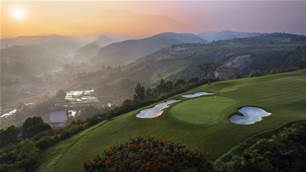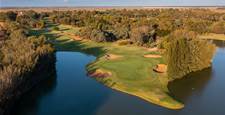The Murray River is Australia’s longest river, meandering more than 2,500 kilometres west from the Australian Alps. And as you could imagine, such a large area provides an enormous number of varied activities to take part in along the famous watercourse.
Beyond water-based activities on offer along the Victorian and New South Wales border, golf is one of the area’s chief attractions. The vast number of courses present a great variation from town to town, while dozens of wineries offer a perfect accompaniment to any trip.
Having long heard positive stories from every type of travelling golfer from boys’ trips playing 36 holes a day to couples dropping in for the odd hit on a more leisurely pace, I was eagerly looking forward to my own first trip playing the Murray courses from Swan Hill all the way to Albury.

MURRAY DOWNS GOLF & COUNTRY CLUB
If you are making your trip down the Murray from the eastern seaboard towards the South Australian border, Swan Hill and Murray Downs is a long way to go. But from firsthand experience, the extra few kilometres is certainly worth it.
Designed by Ted and Geoff Parslow, Murray Downs officially opened for play in 1991 and is now ranked the No.1 course on the Murray after reaching No.46 in Golf Australia’s Top-100 Public Access Courses list earlier this year.
The presentation of the par-72 is outstanding, even during the extreme temperatures of the harsh summer months, with wide, pristine fairways welcoming any level of player, while the course’s large, tiered greens and bunkering force the more talented player to think before hitting.
As to be expected at all courses on the Murray, Red River Gums make up part of the scenery at Murray Downs, but the width of the fairways means the trees don’t play a significant role in narrowing the playing lines.
“Although the 5th hole is unquestionably Murray Downs’ signature hole, two of its closing stretch holes are some of my favourites.”
No mention of Murray Downs is complete without touching on the par-3 5th hole that both dazzles the eye and inflicts nightmares. It is 194 metres from the plates and is played entirely across water. Bunkers help protect the green, which like so many on the course, features heavy undulations. In keeping with the rest of the layout though, there is plenty of room short and left for the shorter hitter or timid player to layup and attempt to get up and down for a three.
Although the 5th hole is unquestionably Murray Downs’ signature hole, two of its closing stretch holes are some of my favourites.
The par-5 16th features water down the left from the tee and at 472 metres from the tips is reachable for many and a realistic birdie chance.
 Played slightly downhill, the 17th is the second- hardest hole on the course despite being a par-4 of just 376 metres. Bunkers populate the fairway where most will try to hit their tee shot. If you manage to safely navigate those, then a short approach to a green with water right and long as well as four bunkers tests your mettle with a good score or match on the line.
Played slightly downhill, the 17th is the second- hardest hole on the course despite being a par-4 of just 376 metres. Bunkers populate the fairway where most will try to hit their tee shot. If you manage to safely navigate those, then a short approach to a green with water right and long as well as four bunkers tests your mettle with a good score or match on the line.
RIGHT: cluBarham Golf & Sports. PHOTO: Brendan James.
CLUBARHAM GOLF & SPORTS
cluBarham is something of a hidden gem for many travelling golfers journeying along the Murray, despite having some holes designed by the acclaimed Ross Watson and being the host course of the longest running two-day pro-am in Australia.
However, speak to experienced Murray visitors and many will tell you they always make a spot on the itinerary for the par-73.
Barham’s stronger holes are on its front side, which opens with an outstanding downhill par-4 that will test players who have hopped out of the car after making the trip from their previous course or lodgings hoping for an easy start.
Measuring 352 metres, the opening hole has two bunkers on the left side that will have many pulling less than driver to find the tight fairway. But the second shot is where the second-hardest hole on the course shows its teeth.
A hazard left and bunker in front of a green set horizontally to the fairway doesn’t look appealing, and standing in the fairway with potentially a mid-iron after hitting less than driver will add to the nerves.
“cluBarham is something of a hidden gem for many travelling golfers journeying along the Murray …”
The next three holes will test all the different parts of your game from long hitting at the par-5 2nd, accuracy at the par-3 3rd to strategy at the par-4 4th. But the run of holes is just a precursor to the club’s famous par-4 5th hole known as ‘Gallipoli’.
There is a story relating to a local armoury that may have helped the naming of the hole, but while I was unable to find someone with an exact memory of the reason for the moniker I left town with the hole burnt in my memory.
Almost perfectly straight, the hardest hole on the course requires an accurate strike from the tee, with dense tree lines down both sides forcing a punch-out back into the fairway for any errant drive. The approach however, is where the hole becomes one you won’t soon forget.
An enormous boomerang shaped bunker is cut out of a significant hill, which the green sits atop. The visual is enough to scare most golfers, the very real prospect of finding the sand causing more than a fair share of players to take too much club and miss long and right of the crowned green.
Find the giant trap and you are not only faced with the lip but an extra 10 or so metres of
closely-mown grass to actually reach the putting surface. There won’t be many birdies at the 5th, but nearly every group will walk away with a story.

RICH RIVER GOLF CLUB
A constant destination for travelling golfers, Rich River’s 36 holes located in Moama – on the NSW side of the Murray north of Echuca – is the closest big-river layout to Melbourne.
The two 18-hole loops, East and West, measure almost identical total distances of just a tick over 6,000 metres from the back tees. But it is typically the East that rates higher among golfers.
The club has recently announced a $6.4million investment into the golf facilities to reenergise the well-known property and attend to some much-needed maintenance requirements.
The design firm Thomson Perrett Golf has been engaged by the club, with one of the stated aims to re-enter the Top-100 Public Access Courses ranking.
A new state-of-the-art irrigation system will replace the existing system across both courses that has been in place for nearly 40 years, while the creation of a spare 37th hole will minimise disruption during the works.
To further enhance the existing golf holes on the property, the fairways and landing areas will be expanded as part of the works and the total number of bunkers will be reduced from 123 to below 80, with the bunkering changed from the existing pot style to better suit the land and course.
The combination of the changes to both courses is expected to bring more risk and reward strategy to Rich River and make it playable for all levels of golfers.
Although the club’s plans are grand and will surely deliver an improved offering at Rich River, the existing holes certainly offer a great experience.
The East Course is characterised by large, sloping putting surfaces that place a premium on finding the same level as the flag. The combination of large greens and mounded surrounds leaves the best short game option in to take as purely a matter of preference in most cases.
During the summer months, the fairways run firm and fast, but being longer isn’t always best on the East, where running through the fairways into the tree lines almost always requires pitching out back to the short grass.

The East Course’s closing four holes are the standout and present a genuine chance at four birdies if your game is on. The dogleg left par-4 15th isn’t long, but water runs down the entire left side of the two-shot hole that features a horizontal green set above the fairway.
Next comes an awkward short par-3 that tests players’ judgement of wind regularly, and will require a close approach for a birdie try on the large green ... Before the penultimate hole, which is undoubtedly what the club is hoping to capture more of in the redesign, with the 346-metre hole a classic risk/reward par-4.
Some days, driver will get up to green high right on the hole that bends left around water up the left and some will even be tempted to produce their Sunday best and take on a line over the drink directly for the green.
Closing the East is the hardest hole on the course, the 532 metre par-5 18th a genuine three-shot hole for most players.
The 18 holes of the West Course are more up and down, and even though the tee shots feel a little more claustrophobic, fewer bunkers guard the greens on the West. The playing surfaces are impressive and there are more bunkers that fit the land on the slightly shorter of Rich River’s layouts.
Related Articles

International Spotlight: Omanu Golf Club

Course Review: Cape Kidnappers












